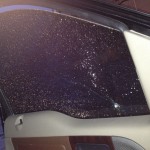 Another one of the many reasons one would consider window tinting is
to reduce energy costs. Yes, its true, applying tint to windows can
actually reduce energy costs up to 50% (Gila)
which is a lot of money over time. When there is heat hitting your
window from outside, the heat travels through the glass and transfers to
the air and other objects that may be in contact with the window. This
is called the heat conduction process.
If tint is applied to the glass, it’s critically designed qualities
allow it to reject a significant amount of UV rays, much more then glass
alone (IWFA).
Because of the material used to create the film it is able to reflect
more light than the glass would have been able to otherwise, reducing
glare, brightness, and even more heat. Because conduction is not
happening as rapidly with the window tint applied, the air conditioner
doesn’t have to work as hard to cool down the air that is getting heated
by the window through the conduction process. This also works the other
way around during the winter by keeping cold outside air from
conducting thought the window to the warm air inside.
Another one of the many reasons one would consider window tinting is
to reduce energy costs. Yes, its true, applying tint to windows can
actually reduce energy costs up to 50% (Gila)
which is a lot of money over time. When there is heat hitting your
window from outside, the heat travels through the glass and transfers to
the air and other objects that may be in contact with the window. This
is called the heat conduction process.
If tint is applied to the glass, it’s critically designed qualities
allow it to reject a significant amount of UV rays, much more then glass
alone (IWFA).
Because of the material used to create the film it is able to reflect
more light than the glass would have been able to otherwise, reducing
glare, brightness, and even more heat. Because conduction is not
happening as rapidly with the window tint applied, the air conditioner
doesn’t have to work as hard to cool down the air that is getting heated
by the window through the conduction process. This also works the other
way around during the winter by keeping cold outside air from
conducting thought the window to the warm air inside. One of the least known uses for tint is to prevent breakage and
provide safety if the glass is ever broken. Annealed (untreated regular)
glass is not very strong and when broken can be very dangerous and
even fatal due to the irregular shaped, sharp shards that it creates
when it breaks. Applying tint to a window adds additional strength and
keeps shattered glass intact if broken, preventing large shards from
flying through the air causing injury. Even with treated or tempered
glass which breaks into small squares, tint would be beneficial because
it not only adds thickness to the glass making it stronger, it also acts
as a protective layer preventing it from scratching and chipping over
time which are all things that could happen regardless if it is summer
or winter. These are just a few reasons why it is still beneficial to
get tint applied in the winter.
One of the least known uses for tint is to prevent breakage and
provide safety if the glass is ever broken. Annealed (untreated regular)
glass is not very strong and when broken can be very dangerous and
even fatal due to the irregular shaped, sharp shards that it creates
when it breaks. Applying tint to a window adds additional strength and
keeps shattered glass intact if broken, preventing large shards from
flying through the air causing injury. Even with treated or tempered
glass which breaks into small squares, tint would be beneficial because
it not only adds thickness to the glass making it stronger, it also acts
as a protective layer preventing it from scratching and chipping over
time which are all things that could happen regardless if it is summer
or winter. These are just a few reasons why it is still beneficial to
get tint applied in the winter.Give us a call for a free quote! 303-936-1362

No comments:
Post a Comment